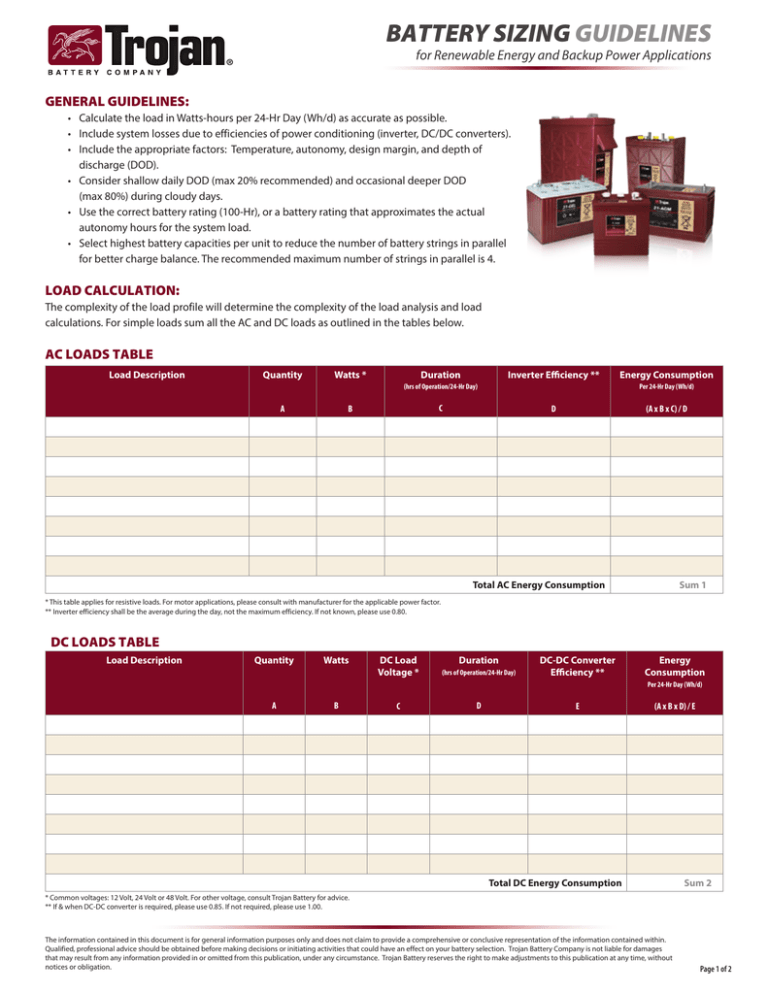
BATTERY SIZING GUIDELINES
for Renewable Energy and Backup Power Applications
GENERAL GUIDELINES:
•
•
•
•
•
•
Calculate the load in Watts-hours per 24-Hr Day (Wh/d) as accurate as possible.
Include system losses due to efficiencies of power conditioning (inverter, DC/DC converters).
Include the appropriate factors: Temperature, autonomy, design margin, and depth of discharge (DOD).
Consider shallow daily DOD (max 20% recommended) and occasional deeper DOD
(max 80%) during cloudy days.
Use the correct battery rating (100-Hr), or a battery rating that approximates the actual autonomy hours for the system load.
Select highest battery capacities per unit to reduce the number of battery strings in parallel for better charge balance. The recommended maximum number of strings in parallel is 4.
LOAD CALCULATION:
The complexity of the load profile will determine the complexity of the load analysis and load
calculations. For simple loads sum all the AC and DC loads as outlined in the tables below.
AC LOADS TABLE
Load Description
Quantity
Watts *
Duration
Inverter Efficiency **
Energy Consumption
(hrs of Operation/24-Hr Day)
A
Per 24-Hr Day (Wh/d)
C
B
D
(A x B x C) / D
Total AC Energy Consumption
Sum 1
* This table applies for resistive loads. For motor applications, please consult with manufacturer for the applicable power factor.
** Inverter efficiency shall be the average during the day, not the maximum efficiency. If not known, please use 0.80.
DC LOADS TABLE
Load Description
Quantity
Watts
DC Load
Voltage *
Duration
(hrs of Operation/24-Hr Day)
DC-DC Converter
Efficiency **
Energy
Consumption
Per 24-Hr Day (Wh/d)
A
B
C
D
E
(A x B x D) / E
Total DC Energy Consumption
Sum 2
* Common voltages: 12 Volt, 24 Volt or 48 Volt. For other voltage, consult Trojan Battery for advice.
** If & when DC-DC converter is required, please use 0.85. If not required, please use 1.00.
The information contained in this document is for general information purposes only and does not claim to provide a comprehensive or conclusive representation of the information contained within.
Qualified, professional advice should be obtained before making decisions or initiating activities that could have an effect on your battery selection. Trojan Battery Company is not liable for damages
that may result from any information provided in or omitted from this publication, under any circumstance. Trojan Battery reserves the right to make adjustments to this publication at any time, without
notices or obligation.
Page 1 of 2
BATTERY SIZING GUIDELINES
for Renewable Energy and Backup Power Applications
TOTAL ENERGY CONSUMPTION CALCULATION
Description
Calculations Steps
Results (units)
Total AC Consumption
Total DC Consumption
SUM 1
SUM 2
(Wh/d)
(Wh/d)
Total Consumption Watt-hours
Per 24-Hr Day
SUM 1 + SUM 2 = SUM 3
(Wh/d)
Battery Bank Voltage
Common Voltages: 12V, 24V or 48V
Total consumption Amp-hours
Per 24-Hr Day
SUM 3 / Battery Bank Voltage =
(V)
(Ahd)
BATTERY BANK CAPACITY (AMP-HOUR):
The battery bank capacity, B(Ah), is the capacity of the battery bank required to run the daily load under normal condition (Total consumption
Amp-hours Per 24-Hr Day - see table above). This battery bank capacity shall be calculated to account for system operational parameters. The
following is a list of battery bank capacity adjustment factors that will serve to calculate the adjusted and final battery capacity required to run
the system appropriately.
ADJUSTMENT FACTORS
Symbol
Parameter
Range
Comments
TC
DA
DM
DOD
Temperature Compensation
Days of Autonomy
Design Margin
Depth of Discharge
Flooded Lead Acid
2 – 10*
1 – 1.25 **
0.2 – 0.8 ***
See Temperature Correction Table
System Dependent *
System Dependent
Shallow – Deep DOD
* For stand alone solar, recommended value is 5 days. For hybrid, recommended minimum value is 2 days.
** Recommended value is 1.10, and typical value is 1.
*** Recommended value is 0.2, and typical value is 0.5.
BATTERY BANK CAPACITY B(AH)
TEMPERATURE CORRECTION FACTOR
(⁰F)
(⁰C)
77
50
32
14
25.0
10.0
0
-10
Flooded
(FLA)
1.00
1.19
1.39
1.70
AGM
GEL
1.00
1.08
1.20
1.35
1.00
1.11
1.25
1.42
Aha =
Ahd x TC x DA x DM
DOD
Aha: Amp-hours adjusted
Ahd: Amp-hours day (from chart Total Energy Consumption Calculation)
TC: from chart Temperature Correction Factor
DA: Days of Autonomy (from chart Adjustment Factors)
DM: Design Margin (from chart Adjustment Factors)
DOD: Depth of Discharge (from chart Adjustment Factors)
BATTERY CONFIGURATION
The battery bank capacity can now be used to determine the amount of batteries needed for the installation.
Description
Calculations Steps
Results
Divide the B(Ah) by the battery’s 100-hour rate (if 5 days autonomy selected) or a rate
Number of Strings
that approximates the actual autonomy hours for the system
A
Number of Batteries Cells /
Monoblocks per String
Divide the battery bank voltage by the voltage of the chosen battery cell / monoblock
Total Batteries Cells / Monoblocks
AxB
Battery Model
Refer to Trojan Battery's Renewable Energy Brochure or www.trojanbatteryre.com
B
call 800.423.6569 or + 1.562.236.3000 or visit www.trojanbatteryRE.com
12380 Clark Street, Santa Fe Springs, CA 90670 • USA or email re@trojanbattery.com
© 2013 Trojan Battery Company. All rights reserved. Trojan Battery Company is not liable for damages that may result from any information provided in or omitted from this
publication, under any circumstances. Trojan Battery Company reserves the right to make adjustments to this publication at any time, without notices or obligation.
TRJN0168 • 10/13 — TRJN0168_BattSizeGuide
Trojan batteries are available worldwide.
We offer outstanding technical support, provided by full-time application engineers.




